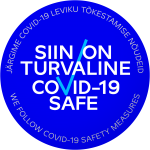The competition project of physical culture centre “Siseõu”. II prize
Erika Nõva, 1939. EAM 2.6.34
Sports and physical culture become the keywords of modern life in the mid-1930s. Planning a representative sports building in Tallinn become on the agenda. A suitable location was found in the Falkpark (today Falgi Park) located at Toompuiestee. In November 1938, the architectural competition was announced. The plan was grandiose: the building had to hold a main hall (20×40 m) for gymnastics, basketball and volleyball, tennis, wrestling, weightlifting and other fields. The stands had seats for 4,500 spectators. Another large room group consisted of a swimming pool (14×25 m) and two saunas, and the third was a gymnasium. In addition to training, dressing and washrooms, office spaces and apartments for officials were also planned. The international competition ended in April 1939. Finnish architects Enn Muistre and Einar Teräsvirta won the first prize, the third prize went to Latvian architect Arturs Reinfelds. Erika Nõva, one of the first female architects in Estonia, received the second prize. The award committee highlighted Nõva’s urban-planningly successful solution “… because the semicircular forms relate architecturally well to multi-directional streets.” The solution of the main hall, the swimming pool and the central part of the building was called magnificent / Eesti Arhitektuur. Varamu arhitektuuri osakond nr 3, 1939/. Erika Nõva recalls: “This job started to bother me. I thought I don’t deserve it, but I couldn’t give up the thought either. Little by little, I began to observe related examples from foreign magazines and tried to sketch it according to the program. When I showed these sketches to Kotli and Soans /… /, they encouraged me to continue working.” / Erika Nõva. Minu töö ja elu. Tallinn, 2006, p. 61/. What follows is a long and cheerful description of the work-hours at night, the draftsman’s assistant Tsinovski (Nopski), the nerve-wracking moments when sending off the work at the post office of Nõmme station, the victory celebration at the “Ehitaja” office and later at Mustamäe’s home. Text: Anne Lass



